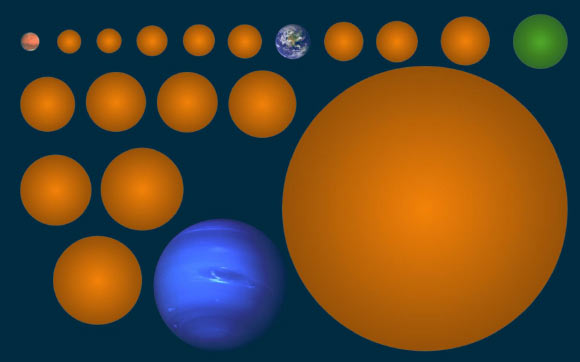Astronomers Discover Seventeen New Extrasolar Planets | Astronomy – Sci-News.com
Using data gathered by NASA’s Kepler space telescope, a team of astronomers in Canada has discovered 17 new exoplanets, including an Earth-sized world. Designated KIC 7340288b, this planet is both rocky and in the habitable zone of its parent star.

Sizes of 17 new planet candidates, compared to Mars, Earth, and Neptune. The planet in green is KIC 7340288b. Image credit: Michelle Kunimoto.
“KIC 7340288b is about 1,000 light-years away, so we’re not getting there anytime soon,” said Michelle Kunimoto, a Ph.D. candidate at the University of British Columbia.
“But this is a really exciting find, since there have only been 15 small, confirmed planets in the habitable zone found in Kepler data so far.”
This planet is just 1.6 times bigger than Earth. It orbits its host star once every 142.5 days at a distance of 0.444 AU (just bigger than the orbit of Mercury in the Solar System) and receives about a third of the light Earth gets from the Sun.
Of the other 16 new planets discovered, the smallest is only two-thirds the size of Earth — one of the smallest planets to be found with Kepler so far. The rest range in size up to 8 times the size of Earth.
In the study, Kunimoto and her colleagues — Dr. Henry Ngo of the NRC Herzberg Astronomy and Astrophysics and University of British Columbia’s Professor Jaymie Matthews — used the transit method to look for planets among the roughly 200,000 stars observed by the Kepler mission.
“Every time a planet passes in front of a star, it blocks a portion of that star’s light and causes a temporary decrease in the star’s brightness,” she said.
“By finding these dips, known as transits, you can start to piece together information about the planet, such as its size and how long it takes to orbit.”
The astronomers also used the Near InfraRed Imager and Spectrometer (NIRI) on the Gemini North 8-m Telescope in Hawaii to capture follow-up images of some of the planet-hosting stars.
“We took images of the stars as if from space, using adaptive optics,” Kunimoto said.
“We’re able to tell if there was a star nearby that could have affected Kepler’s measurements, such as being the cause of the dip itself.”
In addition to the new planets, the team was able to observe thousands of known Kepler planets using the transit method, and will be reanalyzing the exoplanet census as a whole.
“We’ll be estimating how many planets are expected for stars with different temperatures,” Professor Matthews said.
“A particularly important result will be finding a terrestrial habitable zone planet occurrence rate. How many Earth-like planets are there? Stay tuned.”
The team’s paper was published in the Astronomical Journal.
_____
Michelle Kunimoto et al. 2020. Searching the Entirety of Kepler Data. I. 17 New Planet Candidates Including One Habitable Zone World. AJ 159, 124; doi: 10.3847/1538-3881/ab6cf8






